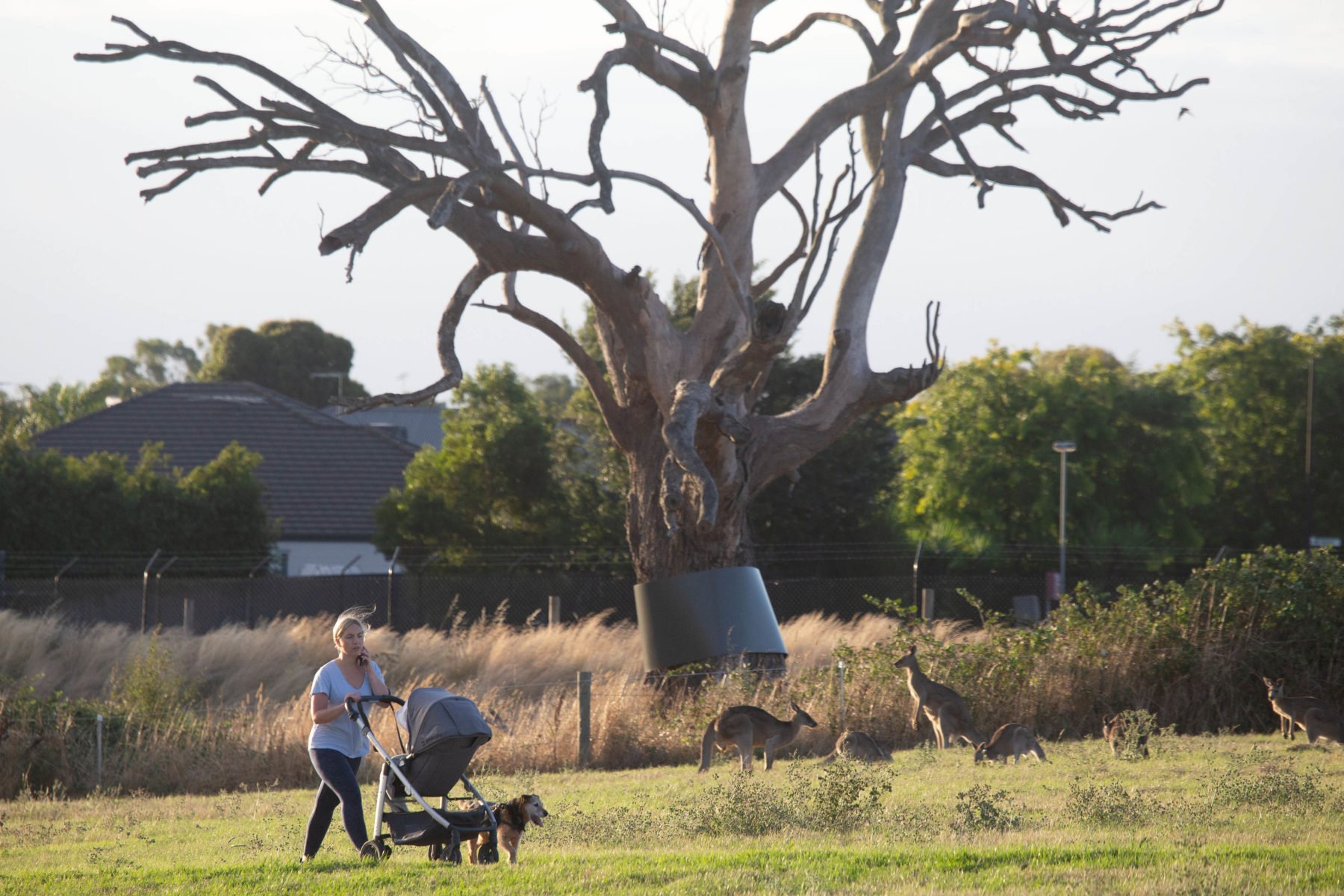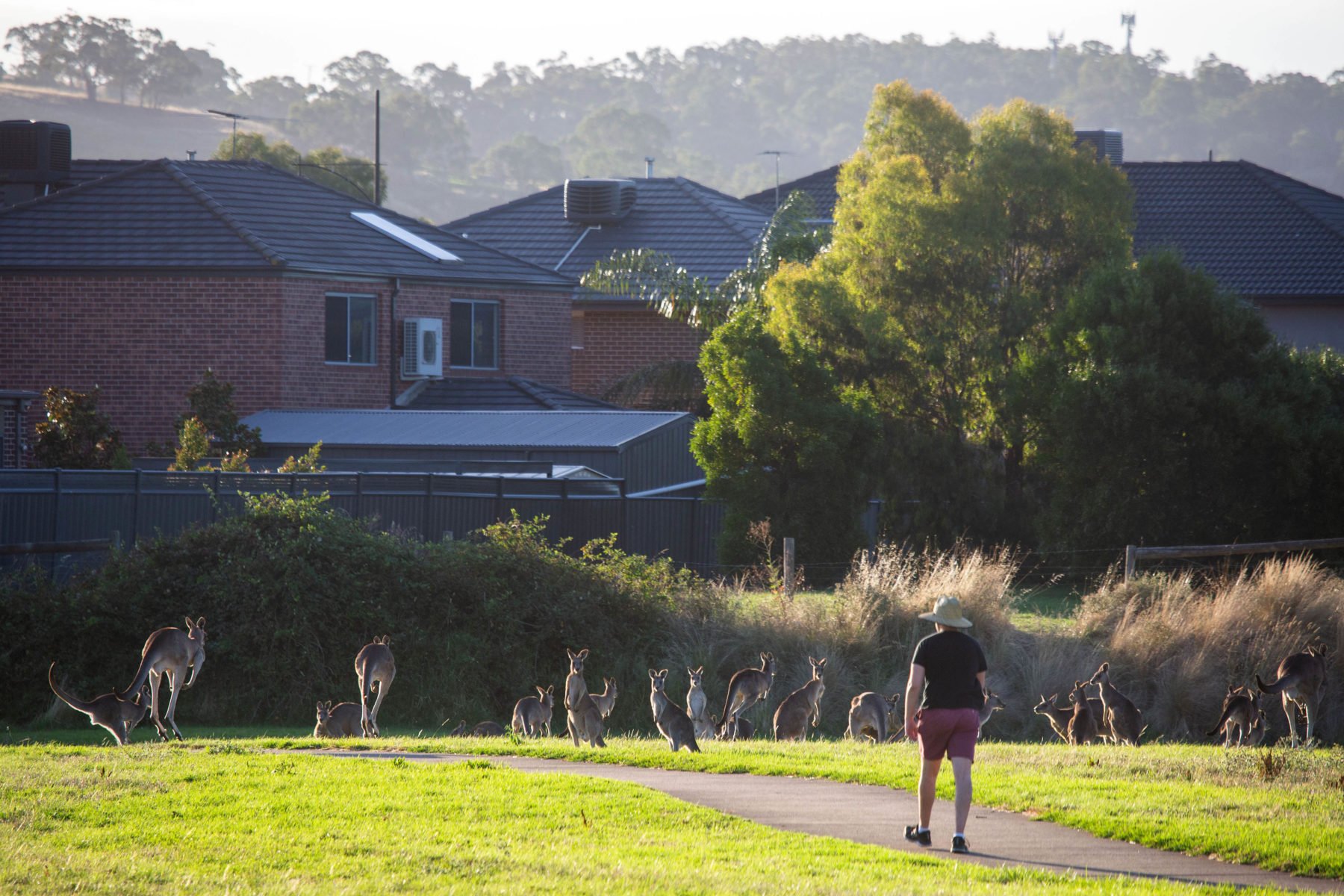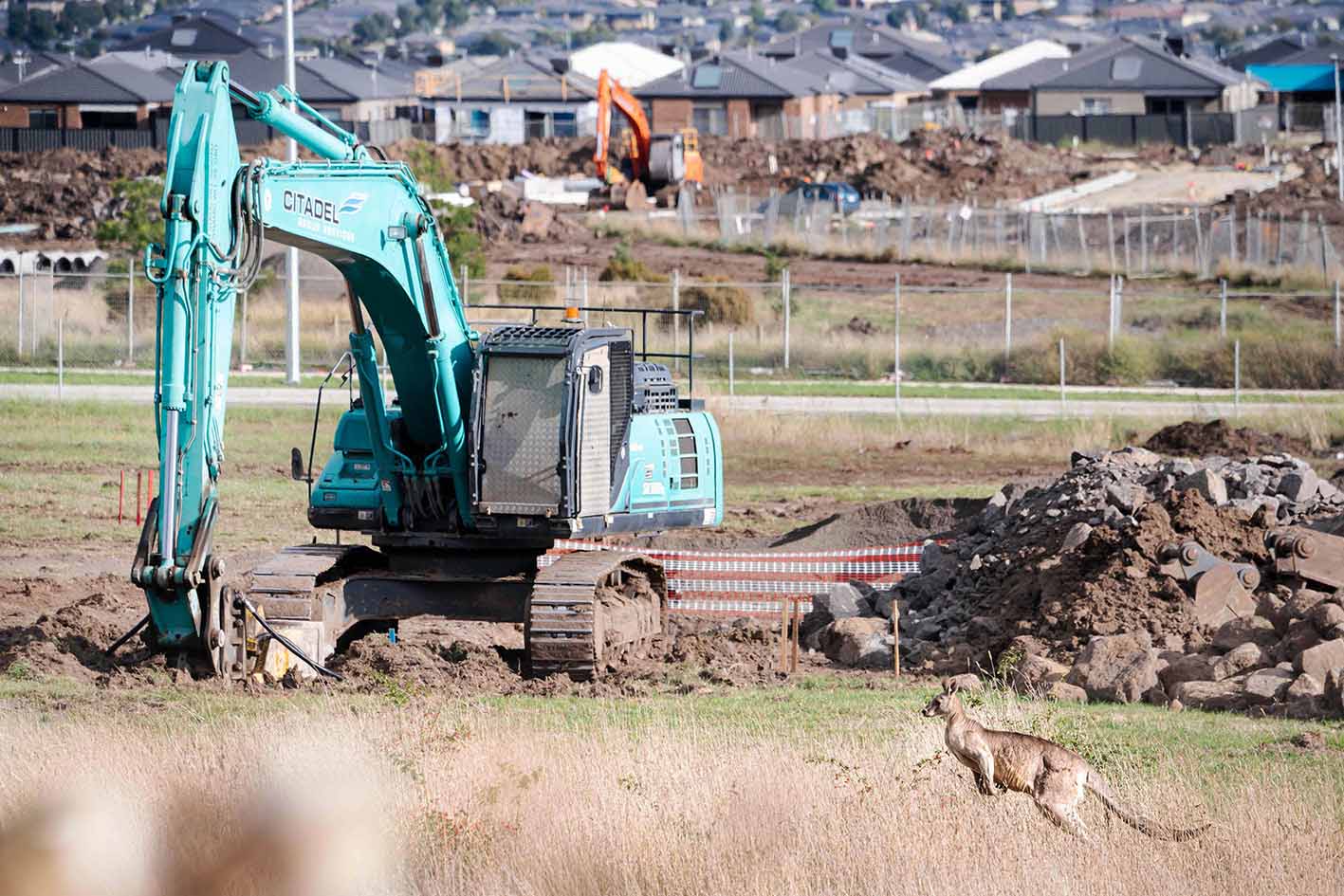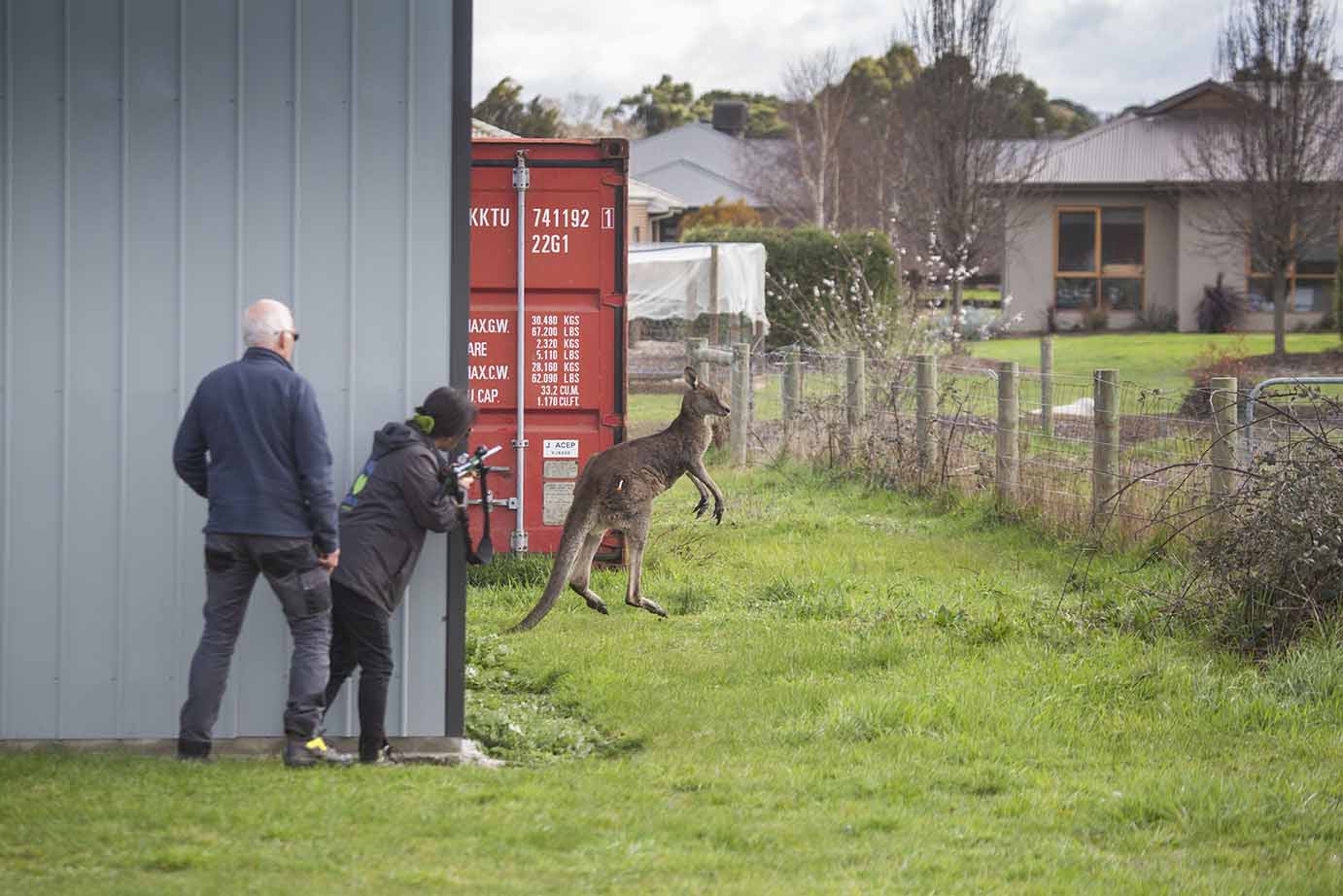“Hi, can you rescue a kangaroo – urgent – trapped in rail corridor, South Morang.“
“Two kangaroos, eastern greys (one with joey) in Mickleham – trapped in construction zone.“
“Greenvale: Kangaroo hit by car. Nowhere to go, due to new estate.“
These are the types of messages flooding the inboxes of volunteer wildlife rescuers based in Melbourne’s outskirts. These messages stream in day and night, seven days a week – a never ending flow of reports of injured kangaroos needing help.
Here, in the outer suburbs of Australia’s second largest city, new neighbourhoods are being built, one after the other, at an alarming rate, on land inhabited by native wildlife.
For an indication of just how fast new housing – and the infrastructure supporting it – is developing, the most recent data from the Victorian Government’s Department of Environment, Land, Water and Planning shows more than 65,000 new lots of land were approved in these outer suburbs from 2018–20 (inclusive).


Growing the most rapidly are the council areas of Melton and Wyndham, with Whittlesea, Casey/Cardinia, and Hume/Mitchell also marked as growth areas by the state government’s Urban Development Program.
Building approvals in these growth areas have also sky-rocketed, with an average of 86,847 new dwellings approved per year in the period 2017–20 (inclusive), according to the Australian Bureau of Statistics.
“It’s increasingly becoming more of an issue,” says registered wildlife rescuer of Banksia Wildlife Kim Davis. “We’re seeing macropods and other wildlife being pushed out of what little habitat they have left.”


For the smaller native animals, death is usually swift.
“Smaller wildlife don’t last,” says veterinarian and founder of Vets For Compassion, Dr Elaine Ong. “It’s just that those little animals die quickly [when construction starts] but the roos survive – some wallabies, too – but mostly eastern grey kangaroos.”
These surviving kangaroos sometimes find their way onto nearby farms or private bushland, where they are often caught in fences that they don’t know how to navigate.
But for many, they suddenly find themselves living in construction sites, or thrust into the middle of suburbia.
Landlocked
“Then, there are situations where they [the remaining kangaroos] are landlocked,” says Kim.
“They might be in one small paddock or yard – either fully fenced or surrounded by roads and new housing estates – so they’ve got nowhere to go.”
Narelle Trippett, a volunteer with The Wildlife Rescuers Inc. sees this dire situation all too often.
“Right now in Greenvale there’s a really small mob of roos trapped on a construction site” she says. “We could open the gate, but then you’re letting them out onto the main road.
“They’re trapped in there. And there’s not a lot of food on those sites.”
‘Completely and utterly lost’
For kangaroos left trying to adapt to their new suburban surroundings, the inevitable consequences are devastating.
“We see a lot of displaced roos running the streets and it’s like a labyrinth to them – they don’t understand,” says Krysti Severi, another volunteer wildlife rescuer, and founder of Rescue Rehabilitate Release.
“I suppose I see them a little bit differently to other people and I can read them a little bit better.
“I can see the anxiety in them when they’re hopping up a footpath or crossing a road or something like that. It’s so foreign to them, they don’t understand. They are completely and utterly lost.”
Tragically, most of these kangaroos are fated to be hit by cars. In fact, car collisions are overwhelmingly the most common reason volunteer wildlife rescuers and veterinarians are contacted.


Kangaroos hit by cars are more often than not euthanased, says Kim.
“In my experience, most of the time, nine times out of 10, we either have to euthanase them or they die because the extent of the injuries when hit by a car are just so severe.”
Dr Elaine Ong explains these injuries range from “broken bones, broken legs, a broken pelvis – to concussions and chest trauma”.
“Also, we see a lot of orphan joeys,” Elaine says. “The mother gets hit and the joey is left alone. The joeys can be rehabilitated and re-released, but for the adult roos, they commonly need to be euthanased.
“It’s heartbreaking, but we are happy we can relieve their suffering.”
Danger at every turn
While the majority of displaced kangaroos are hit by cars, others are attacked by pet dogs, either in off-leash dog parks, or when stumbling into backyards searching for food or a way out. On construction sites, they get entangled in temporary fencing, or fall into deep holes that have been left uncovered.
For others, their bodies are physically worn down over time, as their toenails grind against street surfaces and footpaths.


“Toenail injuries are tricky in kangaroos because their toenails are an extension of their bone,” explains Narelle.
“So once they wear their toenails down, they’ve exposed the bone and if they’re in a real panic they keep hopping and start shaving off their bone. Sometimes they can be rehabilitated, sometimes toenails are worn too far down to the bone and that can’t be fixed.
“Hopping around the streets is not good for them. They need parkland, some soft land, because the pads on their feet and their big toenails are not meant for bitumen.”
Death by stress
And then, there’s the silent killer – myothopy.
“Myothopoy is when, if a kangaroo has been stressed for too long – by being chased by something, or hit by a car, or trapped, or left without water and food – their muscles break down. This releases a byproduct called myoglobin that ends up in the kidneys and they end up dying of kidney failure a couple of weeks later,” explains Elaine. “They can also die suddenly after being stressed from muscle exertion from excess lactic acid produced, excess potassium release, and metabolic acidosis causing oedema and more muscle damage, including to the heart.”
There’s only so much veterinarians can do to treat myothopy in the field.
“We can give them IV fluids to flush out all the toxins and support the kidneys, and give them multivitamins – this at least gives them a chance.”
Licensed vets in short supply
Before Elaine’s Vets For Compassion volunteers can perform any medical treatment on an injured kangaroo, these animals must first be tranquilised.
“We get called out to help because we have dart gun licenses, we can capture them humanely. When you’re trying to catch them you don’t want to stress them, you also need to consider public safety, so the dart gun is the best way,” says Elaine.
“There’s a limited number of people with this license, maybe five in Victoria who do it voluntarily.”
Once tranquilised, the volunteer veterinarians can perform some minor surgery on site, including stitching up torn pouches, cuts, and wounds, as well as performing other small medical procedures.


Then, it’s back to the wildlife rescuers to care for the kangaroos until they wake up from the anaesthetic.
“We dart them and we treat them, then we put them somewhere safe, but the rescuers – they sit there with them until they wake up,” says Elaine. “That could be three hours later, it could be two o’clock in the morning. These amazing rescuers go out and do this every day.”
Learning to live together
Krysti says when she is out rescuing kangaroos all she sees is “bad planning” when she looks at new housing estates. “You don’t see any provision for wildlife out there.”
This is a sentiment shared by Elaine.
“It’s appalling that this is 2022 – we’re not living in barbaric ages – it’s ludicrous that you can bulldoze through the habitat of a couple hundred ‘roos and disregard their welfare.”


So, what can be done to ensure the coexistence of a rising population of humans needing housing and one of our national icons?
One thing most volunteer wildlife rescuers and veterinarians agree upon is that government regulations need to be put in place to enforce that any new urban development needs a pre-planned wildlife management strategy – to be enacted before construction begins, rather than wait until kangaroos are already displaced and there are few solutions.
“It can be really simple things,” says Narelle. “Like when they are starting construction, starting to build at the front of the land and pushing the kangaroos towards the back where the bushland is, instead of starting at the back and pushing all the kangaroos out onto main roads.”
Narelle concedes some developers already do have wildlife management plans, but she says they are not effective.
“It’s often a really simplistic plan,” she says. “For example they create an exit path for the kangaroos – but often that exit path is onto a main road where they end up getting hit.”
Elaine says all stakeholders need to come together to find solutions.
“We are apolitical, we don’t have any alliances. It’s not us and them, we need to all work together for the greater cause.”


What you can do
If you live in a suburban area where kangaroos are present there are some things you can do to help protect them – and you – from injury.
- Do not attempt to get friendly with or feed kangaroos.
- If a kangaroo is overly friendly, that may be a sign that they need help. Please do not approach them.
- As a general rule, keep domestic pets away from kangaroos.
- If you are out walking your dog, keep it restrained if kangaroos are nearby.
- Never put a kangaroo in a position where they feel threatened. Don’t get close up to them, corner them, chase them or follow them down the street.
- If a kangaroo is close by and rears up on its toes, back away.
- If you are driving past a kangaroo in the street, drive slowly so that you can prepare for a sudden stop. Sometimes they might jump out into the path of your car without any warning.
-Advice courtesy Wildlife Victoria
If you see an injured kangaroo:
- If you see a kangaroo that appears to be injured, sick, or overly friendly, take a note of the location and call the local wildlife rescue group in your area.
- Do not attempt to contain or chase the animal as this can lead to extreme stress and further physical injury.
- If a kangaroo is deceased, you can check the pouch for a joey safely by following these steps from Wildlife Victoria.
